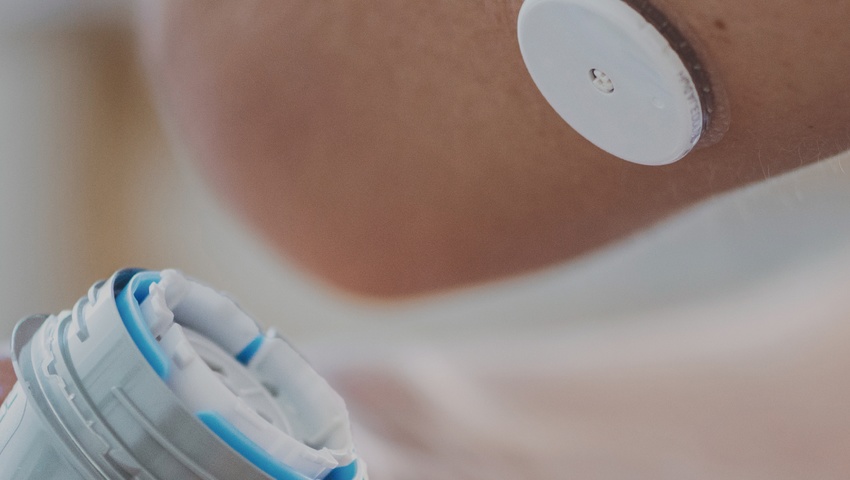
Diabetes goes digital
Continuous glucose sensors, insulin pumps and closed-loop systems are tremendously improving quality of life for diabetes patients.
By Bertrand Beauté
Patients with type 1 diabetes need to keep their blood sugar levels (glycaemia) within a range of 70 to 180 milligrams of glucose per decilitre of blood. But you still need to know your precise blood sugar levels. For many years, diabetics had to prick their fingertip and place a drop of blood on a test strip several times a day. Continuous glucose monitoring (CGM) systems, which measure glucose "in real time", have changed all that. CGMs work using a sensor, which is usually attached to the arm, upper buttock or abdomen, that measures blood sugar several hundred times a day. The latest versions of these devices have an alarm that goes off if the person’s blood sugar is too low or too high, then send all the data to the patient’s smartphone via Bluetooth.
"The emergence of CGM systems has been a tremendous step forward for us diabetics," says French composer Bertrand Burgalat, who has had type 1 diabetes since 1975, when he was 11 years old. He is also the author of the book Diabétiquement vôtre (Diabetically yours) published in 2015. This view is shared by those in the medical profession. "Pricking their fingertip was painful for some patients, even stigmatising," says Dr Karim Gariani, head of the diabetes unit at Geneva University Hospitals (HUG). "In addition to improving quality of life, CGMs help patients to be more aware of their blood sugar levels and therefore stay in the target range longer." Studies have shown that the use Abbott Freestyle CGM reduces the risk of hospitalisation for diabetes patients by 67%.
"The market for continuous glucose monitoring systems currently totals $8 billion per year"
David Kägi, portfolio manager of the RobecoSAM Sustainable Healthy Living Equities strategy
"The CGM market currently totals $8 billion per year," says David Kägi, portfolio manager of the RobecoSAM Sustainable Healthy Living Equities strategy. "So it’s still a nascent market, but it’s growing fast, at around 22% per year. That makes it very attractive to investors." The leading CGM systems on the market today are the FreeStyle Libre 3 from Abbott, which has more than four million users, and Dexcom’s G6.
"More and more type 1 diabetics are choosing to pair CGM systems with pumps, so that they no longer have to do injections with an insulin pen," David Kägi says. As a result, the CGM sends the data it collects to the patient’s smartphone as well as to an automated insulin delivery (AID) system. An algorithm built into the AID then analyses the blood glucose patterns and automatically decides whether insulin should be delivered and how much. A smartphone app displays graphical summaries of glucose and insulin measurements.
"The market for automatic insulin pumps is currently worth $3.5 billion, with growth of 10% per year, slightly less than that of CGMs," says Kägi. Two products lead the AID market: the t:slim X2 insulin pump from Tandem Diabetes and the Omnipod 5 by Insulet.
When glucose monitors and insulin pumps are linked in this way, it is called a closed-loop system. "Closed-loop systems can increase the amount of time spent in the target blood glucose range to 70% to 80% over a 24-hour period, which is 10% more than for a diabetic using traditional technology. Also, the number of hypoglycaemic episodes drops by 50%", says Dr Karim Gariani from the HUG. And the practitioner sees another benefit. Patients feel more at peace. "People with type 1 diabetes often don’t sleep well, because they experience and fear nocturnal hypoglycaemia. They have to get up several times a night to check their blood sugar level," Dr Gariani explains. With closed-loop systems, they no longer have to. They sleep better as the night is not broken up."
40,000
Number of people with type 1 diabetes in Switzerland
Plus, other people than the patient, such as family members, relatives and the attending physician, can check data via an app, thus further improving management of the disease. While type 1 diabetics are the main users of these devices, type 2 patients in the most severe stage of their condition can also use them, as they also require regular insulin injections. Twenty-five percent of type 2 patients are insulin-dependent and can therefore use closed-loop systems. "Closed-loop systems are great for patients," says Pierre Corby from UBP.
However, these devices are no cure-all solution. "Only 10 to 20% of patients use this technology," Karim Gariani says. "Others don’t want to, either because wearing these sensors all the time changes the way they feel about their body, or because they don’t like to do certain tasks such as replacing the sensors or inserting the catheter that injects insulin. In fact, these technologies can even cause anxiety in some people who get obsessed with their data."
Closed-loop systems are also not as automatic as their manufacturers would like us to believe. "The technology is increasingly accurate, but patients still have to enter data into the device and inject additional doses of insulin (boluses)," Dr Gariani says. "I think they will be much more automated within the next five to 10 years."
